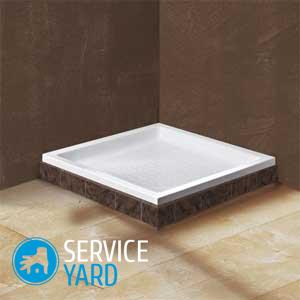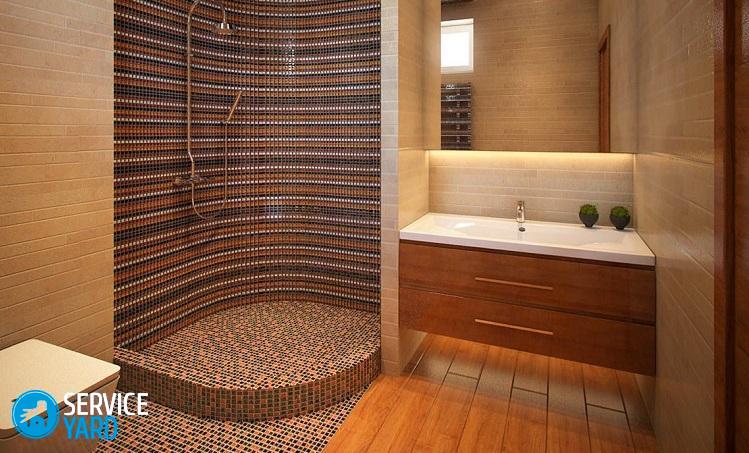How to make a shower tray?

Shower cabins are popular in country houses and city apartments, in private houses. However, not everyone likes the purchased shower stall: it is too flimsy and unstable, especially if the model is budget. A self-made cabin requires a lot of effort and time, but it is much more reliable. Consider how to make a shower tray yourself.
to contents ↑Materials for work
If you want to do independent construction for your own benefit, think carefully before you make a shower tray with your own hands. You are unlikely to save money, because you will need:
- Waterproofing - most likely pool.
- Mortar with the addition of plasticizers to increase the waterproofing effect.
- Tile or mosaic for decoration.
to contents ↑Important! It’s a good idea to have a heated floor so that you can comfortably stand barefoot on the concrete floor in the winter. In short, the event is quite expensive, even if you will not hire craftsmen.
How to make a drain?
Despite the resemblance, there are several options for arranging the soul. Let's consider them in more detail.
Varieties of pallets
The easiest and fastest option is to purchase a ready-made pallet and install it on a base of foam blocks or bricks. There are acrylic and metal (enameled) products on sale:
- Acrylics do not slip and have a small mass. In addition, this material is pleasant to the touch. However, they have a drawback. Over time, they acquire a yellowish tint.
- Enameled - not bad in operation, but glide. I have to use a rubber mat.
Important! If these options are not suitable, the pallet is made of concrete or bricks, followed by lining with mosaics or tiles.
How to make a shower tray from tiles and bricks, then we will consider in more detail. This option is reliable, but laborious. It requires carefully thought-out insulation.
Important! If you equip a shower room in an apartment building, miscalculations with waterproofing are fraught with claims from the neighbors from below. If in private, then you have to suffer from your own negligence yourself.
There is one more option. It can be called a compromise. Boil a tray into the bathroom with your own hands made of metal, treat it with an anti-corrosion compound and install it on the “podium” made of foam concrete or brick.
Dimensions
As for the dimensions of the pallet, there may be such options:
- 800x800 mm is very small. Even a person of a slender complexion will not feel quite comfortable.
- 900x900 mm - a little better, but a bit crowded.
- 1000x1000 mm - quite spacious and comfortable.
Drain arrangement
Two options are possible - gangway and siphon:
- A ladder is more expensive, but its height is less, and it is more reliable. The safety margin is enough for a long time.
- Siphon is less expensive, but not so durable. Throwing it in is not a good idea, because when replacing it you will have to get to it with a punch at the ready. Therefore, from the very beginning, provide an inspection hole with a small door or hatch.
Important! So that, if necessary, the sewer can be cleaned with a cable, it is undesirable to make an angle of rotation to the sewer of more than 30 degrees (45 is the maximum allowable value).
The drain pipe should be laid with a height difference of 4-5 cm per 1 m of length.With approximately the same slope towards the drain, the floor is also made.
to contents ↑How to make a shower tray made of bricks and tiles?
The first requirement for a brick shower tray is a well-leveled floor. If there are any differences, pre-align it with a rough screed. Put the drain device, connect it to the sewer. The further procedure is as follows:
- Waterproofing basics. The easiest option is bitumen, but its smell is not pleasant. Liquid glass, hydrophobic cement impregnation, pool waterproofing are also suitable. The best option, according to experts, is waterproofing for pools. The composition is designed in advance for significant water pressure, and therefore reliable. Concrete-based impregnation is somewhat worse in this regard.
Important! Apply waterproofing in 2-3 layers to be sure that there are no gaps.
- Adhesive tape waterproofing the boundary between the wall and waterproofing. The smallest approach to the floor and walls is 100 mm.
Important! By applying tape, you protect the most vulnerable places in terms of water seepage.
- Laying a brick layer. Brick should be used ceramic full. Silicate bricks are quickly destroyed by moisture.
- Concrete screed filling on beacons. This stage already provides for the arrangement of a bias towards the drain. However, the level of the screed is still slightly lower than the drain, since there is still tiling.
Important! Add compounds that enhance the hydrophobic effect to the screed solution. The best options are liquid glass and PVA building glue.
- After the concrete has hardened, cover it with a layer of waterproofing again. Now it is desirable to apply a hydrophobic layer on a cement basis, since it will be much easier to lay the tile.
- Laying tiles.
- Grouting with a hydrophobic compound.
If you plan to equip a warm floor, there will be 2 more layers:
- After the brick is laid, level the base with a layer of mortar, and lay heating cables on it (on the grid or without).
- Top fill the structure with a special compound for the insulated floor.
- After the mortar has set, you can lay the tiles.
to contents ↑Important! The thickness of the solution layer on top of the cables should not be less than 30 mm. Be sure to form a bias towards the sink.
How to make a pallet from monolithic concrete?
If you plan to form a concrete shower tray yourself, first assemble the formwork. Materials for the manufacture of formwork - a thick board with a thickness of 2.5 cm or trimming fiberboard or OSB (thickness from 1.6 cm).
Important! A prerequisite is the insulation of the concrete floor. To equip a “warm floor” or not is up to you, but you need to warm it. A wooden lattice laid on the floor can help out in the bathhouse of a country house, but this is hardly acceptable for a city apartment.
The operation algorithm is as follows:
- Coat the base with waterproofing. Stick a hydrophobic tape around the perimeter.
- Lay a damper tape around the perimeter or lay a layer of insulation along the walls.
- Install expanded polystyrene with a thickness of 50 mm or more (density from 35 kg / cubic meter). Glue joints with reinforced tape.
- Lay a mesh of metal.
- Guided by the lighthouses, form a drain.
- Lay the screed in 2 layers. Half of the thickness - with a minimum amount of water, the second half with a normal consistency.
- After setting the screed, coat the surface again with waterproofing.
- Only then can floor tiles be laid.
What to make a door from?
A great option is tempered glass. It is very durable, and if it breaks, then into large, non-sharp fragments. The downside of tempered glass is its high cost.
Want to save some money? Make a door from ordinary thick glass, pasting it with a plastic film on both sides. The effect is about the same as with tempered glass: when broken, the fragments remain on the film, and do not fly apart.
Important! Before sticking the film, the glass must first be washed and then degreased.Stick the film on wet glass: working with it is much easier.
Good doors are obtained from sheet (not cellular!) Polycarbonate. You can also purchase the finished product: glass or plastic "accordion".
to contents ↑Stock footage
In this article, we examined in detail the materials and the progress of work so that you can make a shower tray with your own hands. Now all you have to do is decide whether to do it or not.
- How to choose a vacuum cleaner taking into account the characteristics of the house and coatings?
- What to look for when choosing a water delivery
- How to quickly create comfort at home - tips for housewives
- How to choose the perfect TV - useful tips
- What to look for when choosing blinds
- What should be running shoes?
- What useful things can you buy in a hardware store
- Iphone 11 pro max review
- Than iPhone is better than Android smartphones




